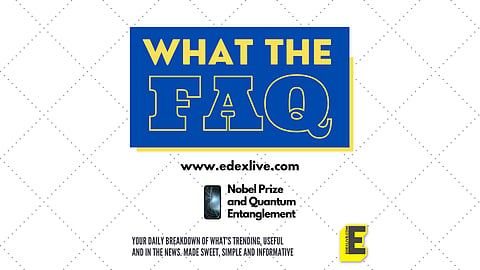#WhatTheFAQ: What makes this year's Nobel Prize in Physics winners special?
While teleportation is still firmly within the realm of science fiction, physicists have cracked the code for quantum teleportation. This means that characteristics of entangled mass will be transferred between the entangled particles regardless of the distance or the lack of physical connection between them. And, there are no hidden variables at play here, as once suspected. The Nobel Prize for Physics for 2022 recognises three physicists who worked towards this discovery.
Who are the winners of the Nobel Prize in Physics 2022?
Alain Aspect of France, John Clauser of the US and Anton Zeilinger of Austria are the three winners of the Nobel Prize in Physics this year. They are scientists, three among the many who have been working on demystifying the Quantum Theory. Their recognition from the Nobel Committee comes on the grounds that they have managed to significantly explain aspects of the theory that left even Einstien bamboozled.
What is Quantum Theory?
Quantum theory explains how matter functions at the sub-atomic level. Essentially, quantum theory applies to those particles like atoms, electrons and lightwaves, which have been observed by scientists to not follow the rules of classic Physics.
What aspect of Quantum Theory did the three Nobel Prize awardees work on?
Entanglement bamboozled celebrated theoretical physicist Albert Einstein. It is a property that states that two particles that interact with each other become entangled. As a result, even if there is a great physical distance between these particles, any action or behaviour of one particle will produce an instantaneous reaction in the other particle, and it was initially believed that this was a result of "hidden variables" at play.
This theory caused Einstien to remark that God doesn't pay dice with the universe. In 1964, Physicist John Bell from Ireland came up with a mathematical solution for this "spooky" phenomenon. The formula states that if there are hidden variables involved, then the result of a large number of measurements will never exceed a certain value.
How did each of the awardees contribute to understanding how entanglement works?
In 1972, Clauser became the first one to perform an experiment based on this formula. He passed entangled photons (particles of light) through polarisation filters and while his experiment showed a violation of Bell's inequality, the conditions of the experiment were challenged because the measurement settings were fixed such that they might not have been able to detect particles controlled by hidden variables.
Then, Frenchman Alan Aspect adjusted the experiment to change the measurement settings after the entangled photons leave the source. Aspects' experiment also violated Bell's inequality and further proved the quantum theory of entanglement.
Then came the work of this year's third joint Nobel awardee, Anton Zeilinger, who worked on more than two entangled particles and demonstrated that entangled particles take on each other's quantum characteristics, regardless of the physical distance between them.
What impact does their work have?
The last bit essentially opened the gateways for quantum teleportation. This can be used to develop communication algorithms that cannot be hacked and develop quantum computers that can perform tasks that were hitherto considered impossible.



